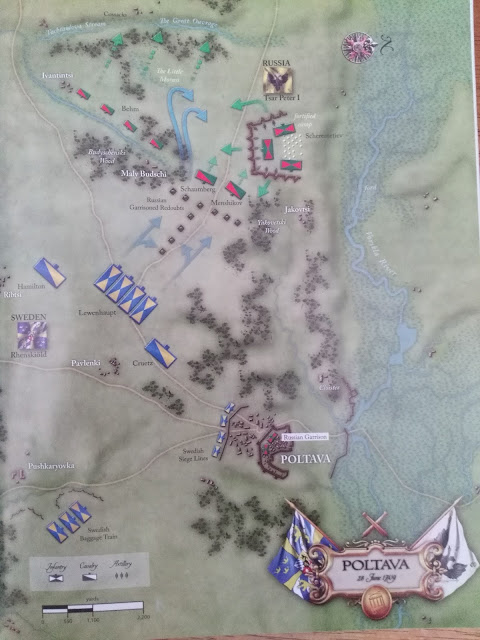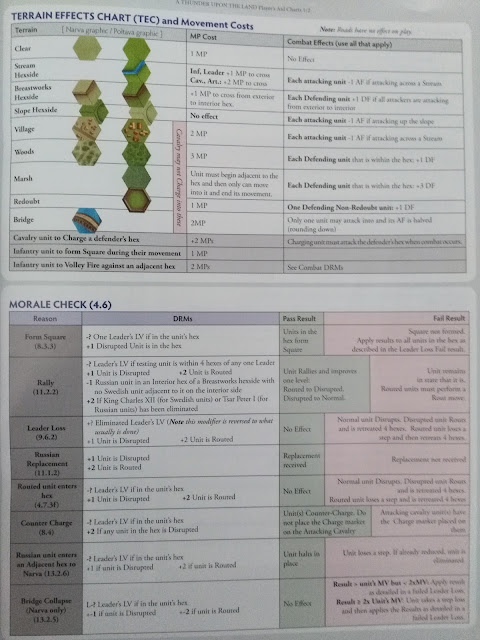 |
| Back of the box |
The game is a bit unusual in that it can be played as a four, three, or two player, but also has rules to play it solo. This is a great mechanic that means the game can be played for game night or when you cannot find anyone. I think more games should have this many options.
 |
| Player shields that also include game info |
Physically the game weighs in at more than four lbs. The box is roughly the size of the old 'soap box' game boxes from SPI. It contains the following:
Four Player Shields - Two Athenian: Aristocrat, Demagogue
Two Spartan: Agiad, Eurypontid (Spartan
Kings' families)
Pericles rules Of Play Booklet
Pericles Playbook
One Sheet Of Counters
Two Athenian Player's Aid Cards
Two Spartan Player's Aid Cards
One Phormio Decision Chart
One Phormio Athenian And Spartan Strategy Matrix
Three Card Decks - Athenian, Sparta, and Aristophanes
One Six Sided Die And One Twenty Sided One
190+ Various Wooden Pieces
 |
| Play map |
The map is beautiful as well as functional. Two thirds of it is a map of Greece, along with small insets for Persia and Sicily. The other third is for the Spartan and Athenian political play. The game itself is the second in the 'Great Statesman Series' ( the first was the highly regarded 'Churchill') designed by Mark Herman. The complexity is listed as a six. Naturally with solo rules it is rated a nine on the 'solitaire suitability' chart. The cards are very interesting and informative. The 'Aristophanes' cards all have a play of his listed on the top of the card. He was naturally a playwright, but he also fought in one of the wars. The counters are 1/2" and are easily readable and well done. They also come with the corners pre-rounded. The colors of the wooden blocks are bright, and the pieces themselves are precision cut with none that are misshapen, etc. These blocks represent the various bases, along with naval and land forces of the different leagues and cities. The play aids are also nicely done and easy to use. They are invaluable with a game of this size and, I don't want to say complexity, but there is a lot going on for the players to keep track of. The rule book is only twenty-four pages long. It is in color and has many examples of play and record keeping. The play book is forty-four pages long. The contents are as follows:
Scenarios, Solitaire and two, three, or four player rules, a full thirteen pages of play examples, five pages of 'Card Personalities' (this is a short bio of important people in the game), Strategy guide, and finally Designer Notes.
 |
| Spartan Player Aid Card |
The game is played in six year turns. The game is interesting because it includes the issue of each side's 'Assemblies'. You are not put in the position of a ruler or omnipotent eye in the sky. This part of the game really shines. The political infighting in the different cities was almost as intense as the actual warfare between them. There are twenty-three historical scenarios to choose from. These run the gamut of small one turn scenarios to 'The Suicide of Greece 460-400 BC' one. Just as in the actual history of the war, there is a chance for plagues to affect play. Alcibiades (the man who helped defend Socrates at the Battle of Delium) even gets his own wooden counter. What more could you ask for in a game about ancient Greece? If I made the game out to seem too complex, in truth it really isn't. All of the books and aids pretty much hold your hand while getting your feet wet in this great game.
I will use the game rules posted on GMT's website (the link is posted below) to show the sequence of play:
" • Aristophanes Card Segment (5.1)
◊ Reveal and resolve the next card from the Aristophanes
deck (and optionally read the play quote out loud in your
best thespian voice)
• Political Cards Segment (5.2)
◊ If player has his Entourage available, discard 0-3 Entourage
Cards (5.21)
◊ Refresh hand to 9 cards, or 6 cards if Entourage used for
Brain Trust option (6.31)
◊ If hand size of 9 create new Entourage of 3 cards (5.23),
else use all 6 cards dealt (6.31)
◊ Add Faction Leader card to 6 cards to create a 7 card hand
• Boule Segment (5.3)
◊ If Hostages available, Controlling Faction has the option
to place War/Peace issue on other City-State’s Opposition
Faction track two space (5.33)
◊ Controlling Factions pick one issue (2 space, 5.32A), except
Ostracism and War/Peace issue (5.32E), which is placed in
the center (zero space).
◊ Opposition Factions pick one issue (1 space, 5.32B), except
Ostracism and War/Peace issue (5.32E), which is placed in
the center (zero space).
◊ Controlling Factions pick three issues (zero space, 5.32C)
◊ Opposition Factions pick two issues (zero space, 5.32D)
Assembly Phase (6.0)
• Starting with the Controlling Faction each City-State sequentially
conducts six debates (6.11, 6.14)
Political Phase (7.0)
• Oration Honor is determined (7.1, Honor 10.0) and Controlling
Faction is determined (7.2)
• Strategy Board Segment (7.3)
◊ Controlling Factions reveal 7th card and receive Strategy
Board Strategos
◊ Opposition Factions reveal 7th card and receive Strategy
Board Strategos
• Political Issues Segment (7.4)
◊ Resolve all non- military, league, diplomatic, and oracle
isues in the following order: War/Peace (7.41, 7.42), Games
(7.43), Citizenship (7.44A), Colony (7.44B), Krypteia
(7.45A), Agoge (7.45B)
◊ Determine if the status change from War to Peace ends the
game (see Scenario instructions)
• Theater Issue Award (7.5)
◊ All Factions substitute their military, diplomatic, league,
and oracle won Assembly issues for their corresponding
Faction colored marker plus their two rumor markers
Theater Phase (8.0)
• Theater Issue Placement Segment (8.3)
◊ In Honor Order (8.1), each player sequentially places facedown
one military, diplomatic, league, oracle or rumor
marker on one of the twenty Theaters and potentially Persia
◊ The placement of a second marker in a Theater or Persia
creates a stack of markers hereafter referred to as a LIFO
(last in, first out) queue (8.31)
◊ Continue sequence until all issues are placed in Theaters
or Persia
• Theater Resolution Segment (8.5)
◊ Reveal and resolve issues (Diplomatic 8.51, League 8.52,
Oracle 8.53, Military 9.0) one at a time to completion in
Honor Order
◊ A player must reveal one marker from his side that is at the
top of any Theater queue
◊ A player who has no markers from his side available to be
revealed passes his turn to the next player
◊ A player who passes still takes his next turn in the Honor
sequence and a player can pass multiple times
◊ In all cases the marker belongs to one of the players and
in all cases the owning player resolves the issue revealed,
regardless of who revealed it
◊ All Theater queue markers must be resolved
◊ After all Theater queue markers have been resolved, move
to the end phase
End Phase (11.0)
• Victory Determination Segment (11.1)
◊ Automatic Victory Determination (11.11, 11.12, 11.13)
◊ If last turn of scenario, determine winner (11.14); otherwise
continue
• Maintenance Segment (11.2)
• Redeployment Segment (11.3)
• Resolve Will of the Assembly (11.4)
• Start new turn"
It seems like an overwhelming mouthful at first, but like many great boardgames the more you put into it, the more you will get out of it.
 |
| Counters |
The game is one of the very few on BGG that has a rating of over 8 (8.10 to be exact), and also has a good number of voters. The game is that good and deserves every decimal point. I will admit to have not had the pleasure to play it in four player mode, but solo and two player are also great gaming fare. The amount of background of history and actual personalities stuffed into the box is an Ancient Greek geek's dream. You should be able to get a credit or two for college for playing the game. Certainly there have been some corners cut in the mechanics of the game compared to real life, but after all it is meant to be a game to be enjoyed. The game plays out, if you use the correct strategy, as the war did. Sparta is the heavyweight on land, and Athens is the heavyweight at sea. It is almost like two fighters, one in an earthen ring and one in a pool beside it. Athens must harass and disturb Sparta by raiding. Sparta desperately wants to come to grips with its enemy. The only way they can is through their different surrogates. Each city of Ancient Greece is up for grabs in this melee. Athens is a super power with an Achilles heel: its citizens' stomachs. Athens cannot feed itself without imports. Sparta has two problems of its own. The first is 'Helots'. These slaves are always on the verge of rebellion. The second is that there are only so many actual Spartans. Their killing off of their own and the extremely hard process to adulthood in Sparta meant that there were never enough full citizen male Spartans.
 |
| Examples of the three decks |
Pericles hits the sweet spot between a wargame and a political game. It also represents the fight for honor that the leading citizens of both sides felt was so imperative. It somewhat resembles the race through the Cursus Honorum of the Roman Republic except that it was much less regulated in the Greek city states. Totally wiping out your opposition, be they demagogues or aristocrats, happened much more frequently in Greece than in Rome. For all our love of the Greek civilization and what it brought us, it was a rough place.
Phormio is the name of the bot or AI that you play against in solo games. Some people have suggested that playing solo is really just a way to learn the mechanics in parts of the game. Others have had an enjoyable time playing solo and still do. While I agree it is a good way to learn the game, it will still give you a run for your money. The design along with all of the components are all top notch. It looks like I will have to pick up the game 'Churchill' soon.
My hat, or pileus, is off to the designer and GMT games for this excellent portrayal of this period in history. The games I have played have pretty much all come down to the wire. So much can happen that, just like in Chess or any good wargame, you always have to have a plan B,C, or D ready to put into play. I must thank the designer for another bit of gaming greatness. It seems (among many others) he was involved with designing 'The Art Of Siege', my favorite wargame of all. So if you have any interest in the age at all, or just want to play a cutthroat wargame, pick this game up. For anyone who is having trouble with the rules or just wants to play well, Mr. Herman has posted some excellent Youtube videos on the game. The only problem I have seen mentioned with the game is to find people who have enough time and commitment to learn and play it. Of course, that is where the alternate number of player rules comes in.
 |
| Play blocks |
This is a link to the final rules:
https://s3-us-west-2.amazonaws.com/gmtwebsiteassets/pericles/PericlesRulesFinal.pdf
This is a link to the final Play Book:
https://s3-us-west-2.amazonaws.com/gmtwebsiteassets/pericles/PericlesPlaybookFinal.pdf
This is a link to 'Just Ask Phormio ; or How to Teach Pericles By Mark Herman:
http://www.insidegmt.com/?p=17470
Robert






























Follow Us